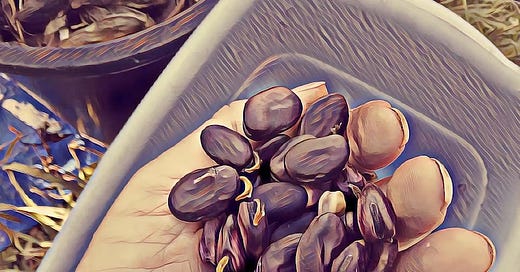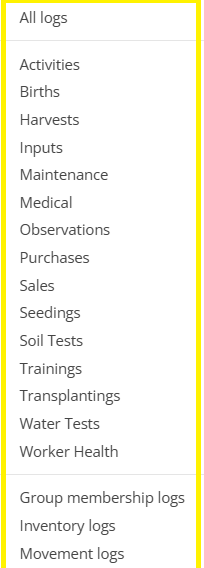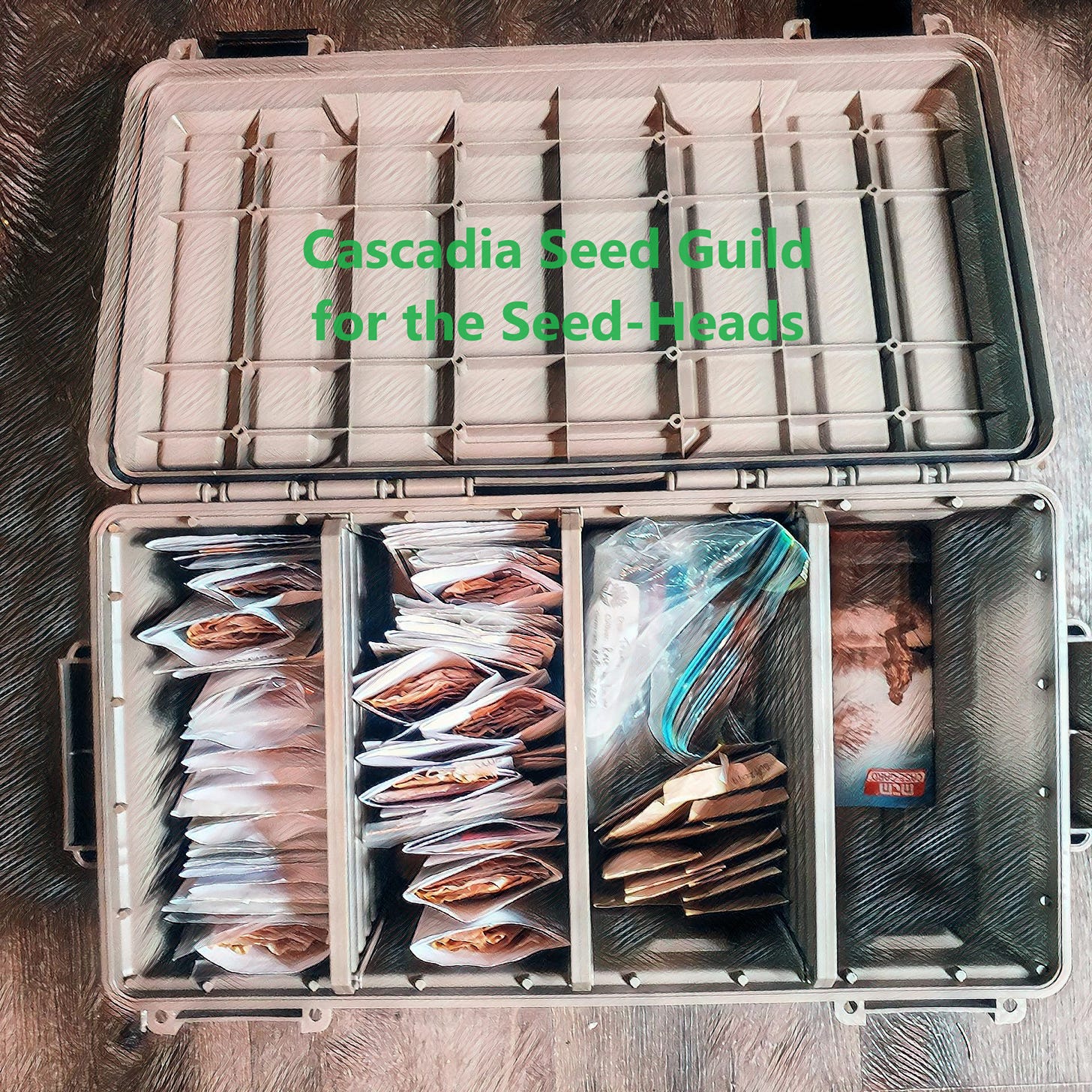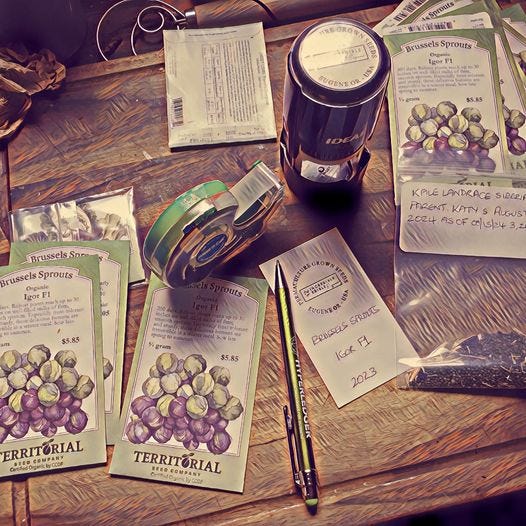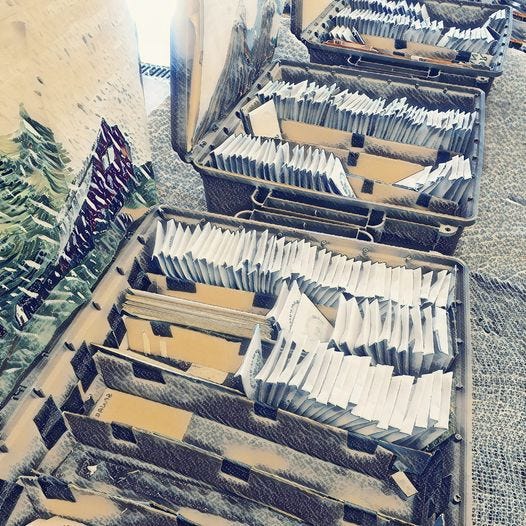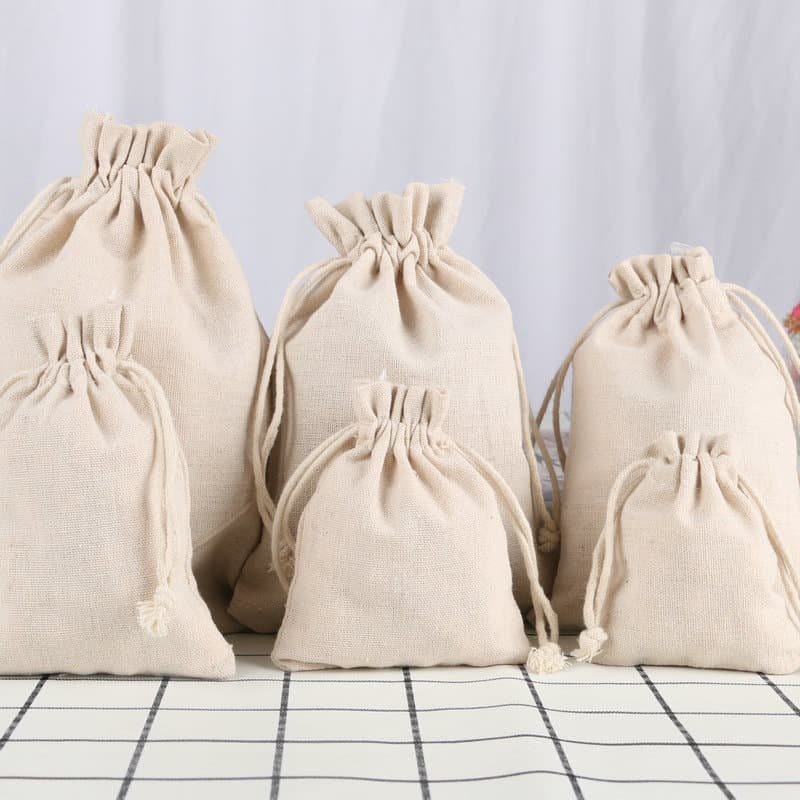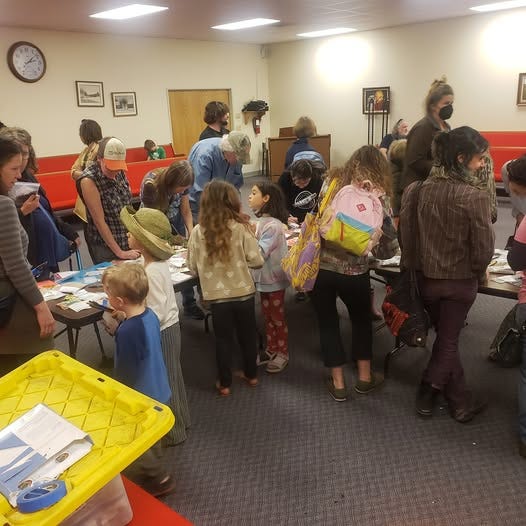Back in 2017 someone gave us a 32ozs Mason Jar filled with some beautiful Fava Bean #Seeds. The timing was just right, we had already been saving seeds since 2015 however the Fava Beans were a pivotal point in our #seed-saving journey.
In this article we will detail how we evolved and built our Seed-Exchange-Library systems. Hopefully this can help you with your own system designs.
Over the years from 2017 to 2022 we continually harvested and re-planted these Fava Beans and the 2022 harvest yielded 8 gallons of dried beans. Our wake-up moment had arrived, solidly. Next we had to completely upsize our #seed-saving capacity and longevity, so here is what we did.
The Ledger.
Luckily, we had evolved a web-based ledger for our seeds work starting back in early 2018, we took an open-source web-based application called farmOS and adapted into our Perma-Ledger application. farmOS was created as a single farm application and we adapted this to support multiple sites in a single area; in our case Eugene OR and area. Here we are showing what can be logged-tracked in Perma-Ledger.
We created a series of YouTube videos on using Perma-Ledger; here is the first in the series.
Just to repeat here; the core application set, farmOS is an Open-Source download which can be found here, so from a cost perspective, getting started on your own ledger (if needed) is not a high-cost option.
Physical Storage Of Seeds
Here we are showing three parts of our seeds storage and distribution systems. One key note point here, all of this is self-funded, although we do get wonderful seed donations, which we appreciate, greatly.
On the left we have the coin-sized envelopes which we use to distribute our Seed Exchange Seeds which we created by breaking bulk donated seeds. These are S-12775 COIN ENVELOPES - WHITE, 2 1/2 X 4 1/4" from ULINE. We are not advertising or promoting anyone here, just revealing what we use, in case this helps.
To the right of these are the hand-made main storage envelopes which are pretty much the same size as a typical seed envelope. We make these from Elementree Printer Paper made from sawmill waste chips. These are 8.5” x 11” standard size and 1 page makes one seed packet.
Sitting below these (in the photograph above) are our main storage boxes, which are Waterproof Ammunition Cases from MTM Case-Gard their ACDC30 Divided Ammo Crate. Once more we are not trying to promote anyone here. We are just sharing our experience over many years of evolving our systems.
This is a view of the inside of our ammo-crate seed storage and yes the Cascadia Seed Guild, our next article will expand on this.
Here we are breaking bulk to spread the seeds donated or grown, as widely as possible.
In addition we have a small freezer and refrigerator and 4 x 18 gallon totes for bulk seed storage, plus our storage at the Eugene Seed Exchange where we use a different sized Waterproof Ammunition Case from MTM Case Gard to accommodate the coin sized envelopes shown below.
Saving Seeds Locally.
One thing, which is puzzling to us, is why saved seeds have little or no monetary value? In our experience, over many years, saved seeds become ever more valuable, because they become more adapted to local soils, climate etc; ongoing. Some words from Joseph Lofthouse and this makes a great deal of sense to us. “A locally-adapted, genetically diverse, promiscuously-pollinating food crop. Landraces are intimately connected to the land, ecosystem, farmer and community. Landraces offer food security through their ability to adapt to changing conditions.“ This is a great book from Joseph Lofthouse.
In addition, Dan Kittredge has some wise words on the power of saving seeds.
One of the most powerful characteristics of saving seeds is the exponential nature of seeds. This is an article on just this exponential nature of seeds that we created.
This is a conceptual drawing of a seed growing-saving center on the outskirts of a city. The USDA estimates that our fresh foods travel up to 1,500 miles on average, from growing to eating. We are wasting resources and polluting our biosphere, unnecessarily. We created a detailed article on creating such centres, here.
Using Desiccants In Seed Storage
As we shared above, we use watertight plastic ammunition cases and plastic totes in our medium to long-term seed storage. Of course, plastic is not seen as ideal for our biosphere. However, until something affordable and superior comes along, plastic is a fact of life. Keeping seeds dry is a key need and we are adding a section on desiccants here.
Using ecologically conscious desiccants is a great way to maintain seed quality while minimizing environmental impact. Here are a few sustainable options that work well and are often reusable:
1. Silica Gel Alternatives (Non-toxic, Reusable)
- Rice: Plain, uncooked rice is a natural desiccant that absorbs moisture effectively. Place a small amount of rice in a breathable bag, like a muslin or cheesecloth pouch, and add it to your seed storage container. This method is both biodegradable and reusable. You can dry rice out and reuse it multiple times.
- Bentonite Clay: Bentonite clay is an effective and reusable desiccant, which can be found in pellet form and reused by drying it in the oven at a low temperature. Look for natural, food-grade clay if possible. It’s often sold as a moisture absorber for closets or small spaces.
- Salt and Epsom Salt: Salt or Epsom salt in a small, breathable cloth bag can absorb moisture quite well. Salt can be dried out and reused, but make sure it doesn’t come in direct contact with seeds, as it can be corrosive or damaging if it draws too close to your envelopes.
2. Charcoal
- Activated charcoal is another natural desiccant that can help absorb moisture. It works well in small, contained spaces and is reusable after drying in the sun or in an oven. Charcoal has the added benefit of helping to absorb odors and any potential contaminants in your storage container.
3. Baking Soda
- Baking soda is known for its moisture-absorbing properties. Place it in a small, perforated container or fabric pouch to prevent it from making direct contact with your seeds. This is also a low-cost, renewable option and can be reused by drying it periodically.
4. Dried Herbs (Natural Desiccants with Added Benefits)
- Certain dried herbs like rosemary, thyme, or sage have slight moisture-absorbing properties and can help keep the air in storage containers dry. While not as powerful as other desiccants, they add a gentle aromatic layer that can deter insects. Using dried herbs is an eco-friendly, compostable option that can be rotated with each new season’s seeds.
5. DIY Regenerative Desiccants
- If you prefer to purchase a desiccant that can be regenerated, look for brands that offer silica gel packs labeled as “non-toxic” and “reusable.” Many brands now produce silica desiccant packs designed to be dried out in the oven and reused repeatedly, minimizing waste.
Instructions for Use and Reuse:
- Regenerating Desiccants: To dry out reusable desiccants like rice, bentonite clay, or charcoal, place them in an oven at low heat (about 200°F or 93°C) for 1-2 hours. Once dried, they’re ready to use again.
- Storage Suggestions: Use small pouches or containers to prevent direct contact with seeds, as some desiccants can produce fine dust that may damage seeds or create messes.
These options provide an eco-friendly way to manage moisture without synthetic chemicals, keeping your seed storage both dry and sustainable.
Seed Exchange Management
We are adding this section to share how we manage Seed Exchanges during the Agrarian Sharing Network Annual Propagation Fairs. We touched on these and their benefits; here.
Seed Sources
2025 was a halcyon year for ASN’s Seed Increase Initiative (ASNSII), it is the first year that all seeds within ASNII 2025 issuance were grown in and around the South Willamette Valley. This is a key benefit to all of us, we covered the ASNII initiative in this article.
Locally Grown & Saved - Often Landrace varieties, we covered Landraces here. One thing which we think about often is why locally saved seeds have little to value?
Seed Company Donations - We are often graced by such donations and are very grateful for such generosity.
Seed Vendor Donations - We are, once more, often graced by such donations and are very grateful for such generosity.
Eventually, all seeds will go through a “breaking-bulk” process so that we can share them as equitably as possible, however, before this.
Perma-Ledger - All our seed work has been monitored for the past 4-5 years in our web-based intranet application, Perma-Ledger. This is sample entry and as can be seen, each seed has a QR Code.
We also use AI to help gather current details on all identified seeds received.
Storage - We covered storage in this article, above.
Distribution - Obviously we have the annual Agrarian Sharing Network (ASN) Propagation Fairs throughout the Pacific Northwest of the USA.
We also maintain one permanent seed exchange in Eugene, OR at Eugene Backyard Farmer so seeds go out via there and we can never seed to keep up with this, adequately. Genuinely we have lots of seeds, it is the processing of them which slows us down; however we will keep this going and have also help Eugene Public Library with their Seed Library,
Conclusion.
We hope this article has given help to those wishing to set up their own seed-saving operation and of course welcome all comments and questions here. If you are interested to host a Seed Exchange please feel free to leave a comment.

